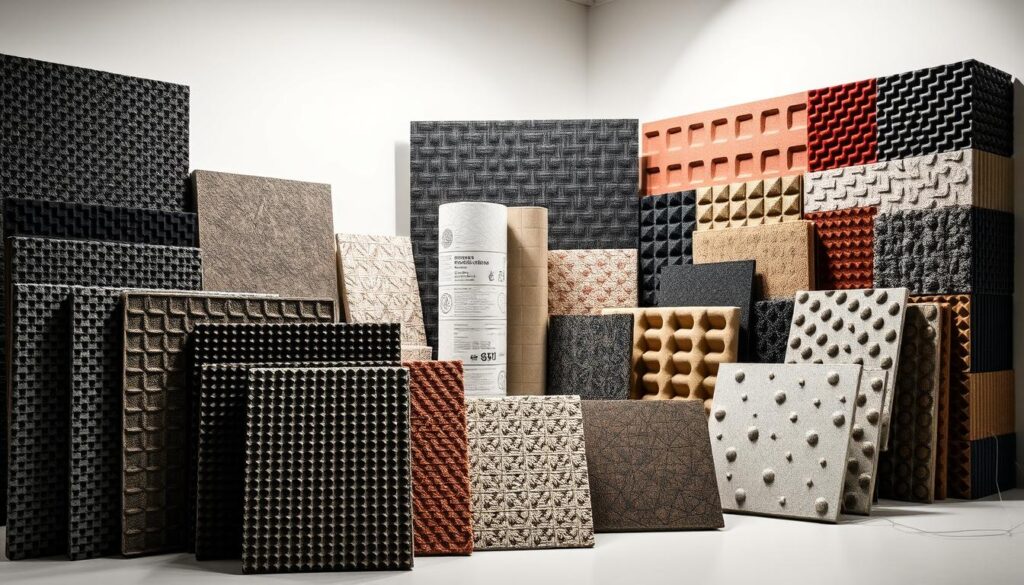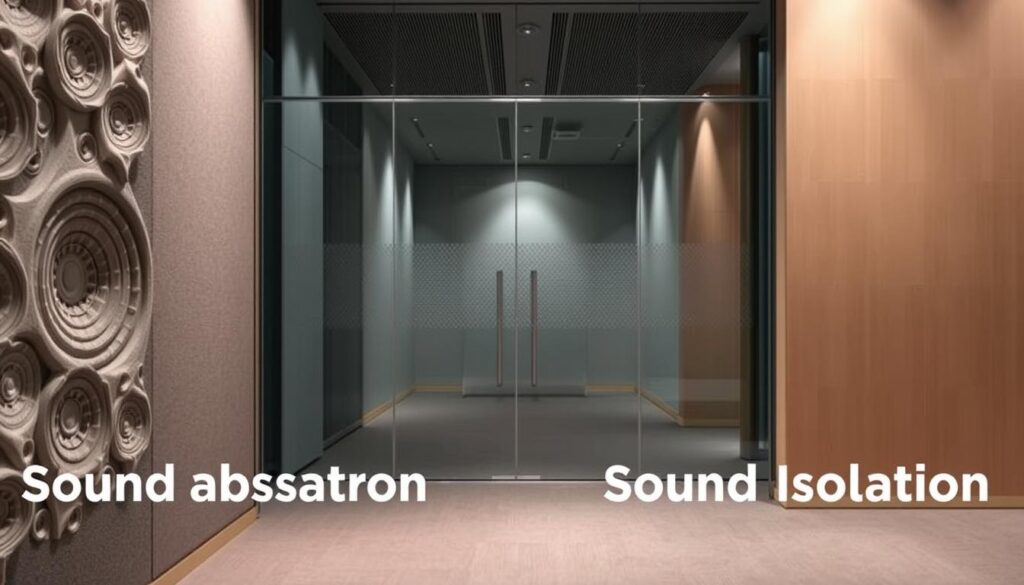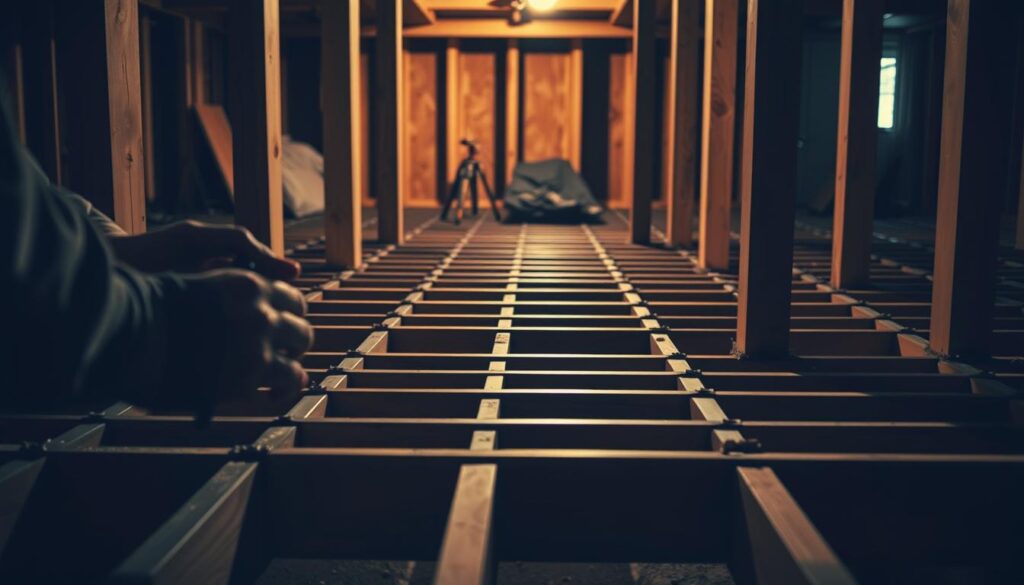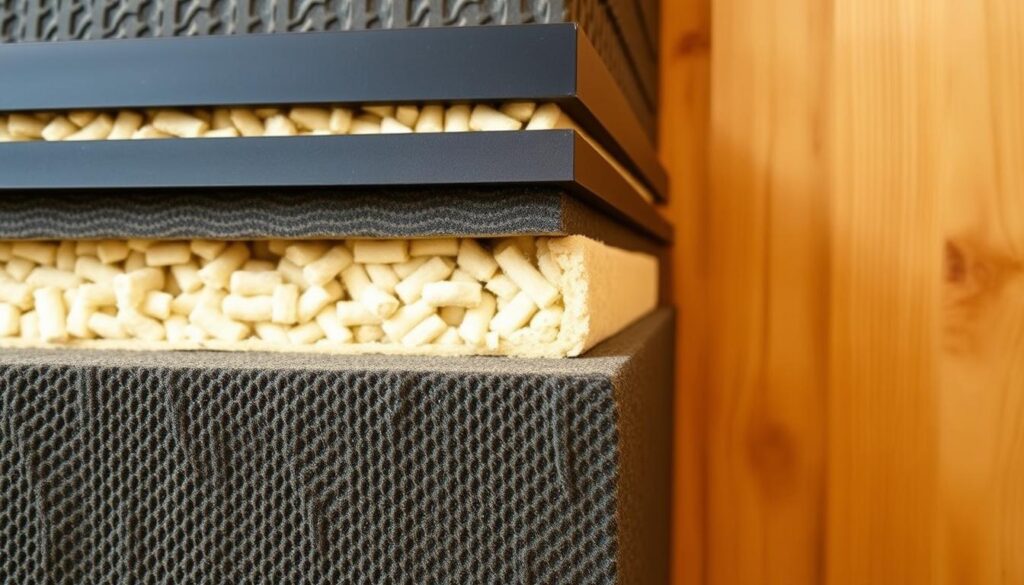When building or renovating, you aim for a quiet and comfortable space. Sound Transmission Class (STC) ratings help you achieve this. They show how well materials block unwanted noise.
STC ratings measure a material’s sound-blocking ability. They tell you how well a material stops sound from passing through. The higher the STC rating, the better it blocks sound.
Knowing STC ratings helps you pick the best soundproofing materials. This ensures your space is peaceful and private.
What is Sound Transmission Class (STC)?
The Sound Transmission Class (STC) rating shows how well a building partition blocks airborne sound. It’s key for architects, builders, and homeowners wanting better sound comfort in buildings.
STC is a number that shows how well a partition blocks sound. It’s found by measuring sound loss at different frequencies and comparing it to standards. This helps in designing buildings that meet soundproofing needs.
Understanding STC Ratings
Higher STC ratings mean better soundproofing. For example, a partition with an STC of 50 blocks sound better than one with a 30 rating. The noise reduction levels a partition achieves depend on its STC rating, making it key for acoustic insulation.
STC ratings are found through tests that measure sound loss at various frequencies. These tests are done in controlled settings for accurate results.
Importance of STC in Building Design
In building design, STC is vital for soundproofing. By picking materials with the right STC ratings, builders can cut down noise and improve privacy. STC’s role is clear in boosting the acoustic comfort of building occupants.
When designing buildings, it’s important to think about STC ratings for walls, doors, and windows. This helps create spaces that are both functional and quiet.
How is STC Measured?
To measure STC, a controlled environment is set up. It compares sound pressure levels in two rooms. This is key to see how well materials block sound.
Overview of Testing Procedures
The STC test measures sound loss through materials. It’s done in a lab with two rooms separated by the material. Sound pressure levels are measured in both rooms. The difference shows the STC rating.
The test starts with noise in one room (the source room). Sound pressure levels are measured in both rooms. The difference shows how well the material blocks sound.
Factors Considered in Measurement
Many things are looked at when measuring STC. These include the material type, thickness, and any gaps or cracks. Impact sound is also key, as it greatly affects soundproofing.
- The sound frequency range tested
- The material or assembly size and shape
- Any paths that could go around the material being tested
Knowing these factors is crucial for meeting STC requirements in building. Architects and builders can make sure their projects are soundproofed well by considering these points.
Why STC Ratings Matter for Homeowners
For homeowners, STC ratings are more than just a technical detail. They show how well a home can keep it quiet. Knowing and using the right STC ratings can make your home more comfortable and private.
Enhancing Privacy in Living Spaces
A higher STC rating means your walls, floors, and ceilings block sound better. This makes your home more private. It’s very important in places like apartments or multi-story homes where noise from neighbors can be a big problem.
By making sure your home meets the STC rating standards, you can have a more private living space.
Reducing Noise Pollution
STC ratings also help reduce outside noise. If you live in a busy city or near a highway, a well-insulated home with a high STC rating can keep outside noise low.
This makes your life better and can even increase your home’s value. People looking to buy a home often want a quiet place to live.
Common STC Ratings and Their Meanings
Understanding Sound Transmission Class (STC) ratings is key to soundproofing. STC ratings show how well a wall, door, or window blocks sound. This helps you know how quiet or private a space will be.
STC ratings are more than just numbers. They tell you about the privacy and quietness of a space. Different parts of a building have different ratings based on their materials and design.
Walls
Walls are vital for soundproofing. Their STC ratings can change a lot based on how they’re built. A simple drywall wall might have a low STC rating, around 30-40.
But, a wall with extra layers of drywall, insulation, and special channels can block sound better. It can get an STC rating of 50 or more, making it much quieter.
| STC Rating | Description |
|---|---|
| 30-40 | Low soundproofing; normal speech can be understood. |
| 45-54 | Moderate soundproofing; loud speech can be understood, but normal speech is not clear. |
| 55-64 | High soundproofing; loud speech is not clear, and normal speech is barely audible. |
| 65+ | Very high soundproofing; even loud sounds are significantly reduced. |
Doors
Doors are also important for soundproofing. A regular interior door usually has a low STC rating, around 20-30. This makes it a weak spot for sound.
But, solid-core or soundproof doors can block sound better. They can have an STC rating of 40 or more if they’re sealed and installed right.
- A standard interior door: STC 20-30
- A solid-core door: STC 30-40
- A soundproof door: STC 40+
Windows
Windows also have different STC ratings. Single-pane windows have lower ratings, around 20-30. But, double or triple-pane windows can have ratings above 40.
The frame’s design and how well it’s sealed also affect a window’s STC rating.
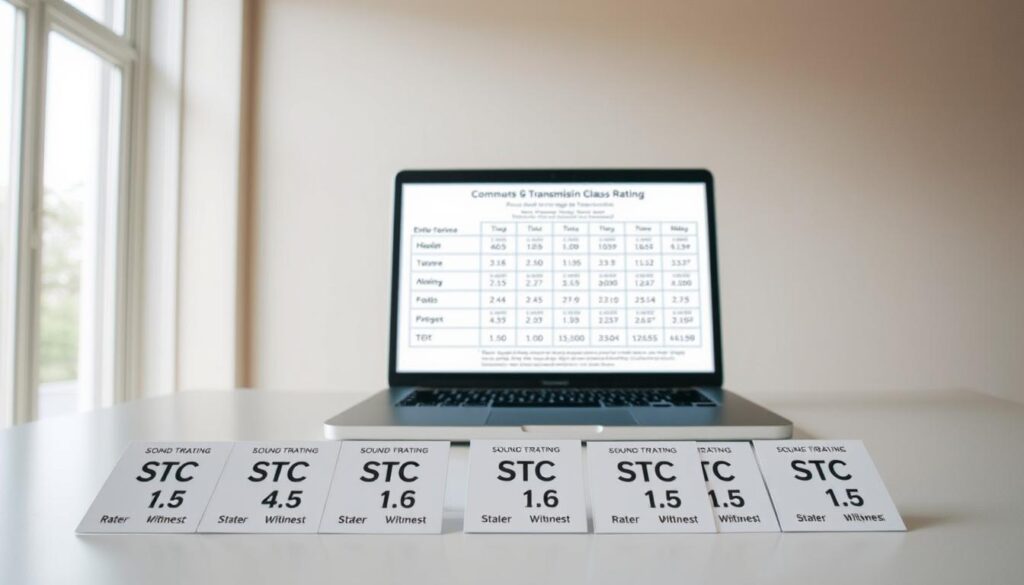
Knowing these ratings helps you choose the right materials and designs for your building. This ensures you get the soundproofing you need.
Ideal STC Ratings for Different Spaces
The right STC rating changes a lot depending on the space. Residential areas and commercial buildings have different needs. This is because of their use and who uses them.
Residential Areas
In homes, sound insulation is key for privacy and comfort. Bedrooms and living rooms need high STC ratings. This helps block out noise from outside or next rooms.
Recommended STC Ratings for Residential Areas:
| Space Type | Ideal STC Rating | Noise Reduction Level |
|---|---|---|
| Bedrooms | 50-60 | High |
| Living Rooms | 45-55 | Medium to High |
| Home Theaters | 60-70 | Very High |
Commercial Buildings
Commercial spaces need different soundproofing levels. Offices might not need as much as recording studios or conference rooms. These places need high ratings to keep things quiet and private.
Recommended STC Ratings for Commercial Buildings:
| Space Type | Ideal STC Rating | Acoustic Insulation Level |
|---|---|---|
| Offices | 40-50 | Medium |
| Conference Rooms | 50-60 | High |
| Recording Studios | 70+ | Very High |
Knowing the right STC rating is crucial for good sound insulation. By picking the right STC, your space will meet soundproofing standards. This is true for both homes and commercial buildings.
The Role of STC in Soundproofing
Sound Transmission Class (STC) is key to making spaces quieter and more private. It measures how well a wall or floor blocks sound. A higher STC rating means better soundproofing.
Improving STC Ratings
To boost STC ratings, several strategies work well. Adding mass to walls helps, as denser materials block sound better. Soundproofing materials with high absorption coefficients also help. These can be placed inside walls or used as finishes.
Key Strategies for Improving STC Ratings:
- Adding mass to walls and ceilings
- Using soundproofing materials with high sound absorption coefficients
- Sealing gaps and cracks to prevent sound leakage
- Installing acoustic panels to reduce echo and sound reflection
Materials That Enhance STC
Some materials are great at boosting STC ratings. Mass-loaded vinyl, acoustic caulk, and resilient channels are top choices. Mass-loaded vinyl, a thin sheet with heavy metal, is a top sound barrier. Acoustic caulk seals gaps and joints, stopping sound from escaping or entering.
| Material | Description | STC Enhancement |
|---|---|---|
| Mass-loaded Vinyl | A flexible sheet loaded with heavy metal particles | Up to 25 STC points |
| Acoustic Caulk | Specialized caulk for sealing gaps and joints | Prevents sound leakage |
| Resilient Channels | Metal channels that decouple drywall from studs | Improves STC by reducing sound transmission |
Knowing how STC works in soundproofing and using the right materials can greatly improve your space’s soundproofing. This makes your building or home quieter and more private.
STC Ratings vs. Other Sound Ratings
STC ratings are key in soundproofing. They show how well soundproofing works. It’s important to know how STC ratings compare to other sound ratings when choosing soundproofing for your building.
Comparing STC with NRC and IIC
STC (Sound Transmission Class) ratings measure how well a material or assembly blocks sound. NRC (Noise Reduction Coefficient) looks at how much sound a surface absorbs, not transmits. IIC (Impact Insulation Class) ratings check how well a floor assembly stops impact noise.
STC deals with airborne sound, while IIC looks at structure-borne sound. NRC helps understand how surfaces reduce echo and ambient noise. Each rating gives important info for soundproofing.
Why STC is the Standard Measurement
STC is the top choice for soundproofing because it focuses on airborne sound. Building codes often require specific STC ratings for walls, doors, and windows. This ensures buildings meet soundproofing standards.
Knowing about STC ratings helps you choose the right soundproofing solutions. This knowledge lets you pick materials and designs that block sound well. It makes your building more comfortable acoustically.
How to Interpret STC Ratings
To get the best sound insulation, knowing STC ratings is key. Sound Transmission Class (STC) ratings show how well a wall or ceiling blocks sound. This knowledge helps you choose the right soundproofing for your space.
Understanding High STC Ratings
A high STC rating means a building element blocks sound well. For example, a rating of 50 or higher is good for soundproofing. It makes it hard to hear normal speech and impossible to hear loud speech.
Key Benefits of High STC Ratings:
- Enhanced privacy in living and working spaces
- Reduced noise pollution from external sources
- Improved overall acoustic comfort
Limitations of STC Ratings
STC ratings are useful but have limits. They don’t measure low-frequency sounds, which can be a big problem in some places. Also, the rating is from lab tests, and real-world performance can differ.
Considerations for Interpreting STC Ratings:
| STC Rating | Soundproofing Effectiveness | Typical Application |
|---|---|---|
| Below 30 | Poor | Thin walls or partitions |
| 30-50 | Fair to Good | Standard residential construction |
| 50-60 | Good to Excellent | Soundproofing for homes and offices |
| Above 60 | Excellent | Professional recording studios and sound-sensitive areas |
Knowing what STC ratings mean and their limits helps you make better soundproofing choices. Whether you want better privacy, less noise, or better sound quality, understanding STC ratings is key.
STC Rating Recommendations for Construction
When building a new place, picking the right Sound Transmission Class (STC) ratings is key. This ensures soundproofing works well. The right materials can greatly cut down on noise, making the space more comfortable.
Choosing materials with the right STC ratings is a big deal in building. Materials with higher STC ratings block more noise. For example, a wall with an STC of 50 blocks more sound than one with a 30 rating.
Material Selection Based on STC
To get the best soundproofing, pick materials that match the STC ratings needed for each part of a building. Walls, doors, and windows all need different STC ratings, depending on their use.
| Building Component | Recommended STC Rating | Example Materials |
|---|---|---|
| Walls | 45-55 | Double-layer drywall, insulation |
| Doors | 30-40 | Solid core or metal doors |
| Windows | 25-35 | Double-glazed windows |
Talking to experts is also crucial. They help make sure the materials you choose fit your soundproofing needs. They know the best materials and how to install them for the best STC ratings.
Consulting with Professionals
Working with skilled contractors and acoustic experts is helpful. They guide you through STC ratings and soundproofing. They suggest the best materials and methods for your project, making sure it meets building codes.
By focusing on STC ratings and getting expert advice, you can make a more comfortable and useful building. Good soundproofing improves the space’s quality and adds value to the property.
Common Misconceptions about STC Ratings
Many builders don’t fully understand STC ratings, which are key in soundproofing. There’s a lot of confusion about what they mean and how to use them. Let’s clear up some common myths.
Debunking Myths
One myth is that a higher STC rating means a space is completely soundproof. But, STC ratings measure how much sound is reduced, not eliminated. For example, a wall with an STC rating of 50 doesn’t block all sound. It just reduces it by a certain amount.
Another myth is that STC ratings cover all types of sound. They mainly measure airborne sounds like voices or music. But, they don’t measure impact sounds like footsteps. For impact sound, you need to look at the Impact Insulation Class (IIC).
Clarifying Misunderstandings
Many people don’t get how STC ratings are calculated. The rating comes from tests that show how well a material or assembly blocks sound. It’s not just about the material’s thickness or density. It’s about how it’s built and installed.
STC ratings also don’t stand alone. They’re part of a bigger picture that includes other sound metrics. When planning soundproofing, think about how STC ratings work with NRC (Noise Reduction Coefficient) and IIC. This helps you reach your sound control goals.
By clearing up these misunderstandings and myths, you can make better choices for soundproofing. Whether you’re a homeowner or a builder, knowing about STC ratings is crucial. It helps you achieve your sound goals.
Future of STC Ratings in Building Codes
Building codes are changing, and STC ratings will become more important. They will help make sure soundproofing meets the rules. Expect new rules for sound ratings in buildings.
Emerging Trends
New rules for sound are coming. They aim to make buildings quieter and more comfortable. This change will lead to new soundproofing materials and methods.
Advancements in Soundproofing
New soundproofing tech is coming. Scientists and builders are working on better materials and ways to build. This will help make buildings quieter and more comfortable.
Keep up with these changes to make sure your buildings are up to code. This will make living spaces better for everyone.
